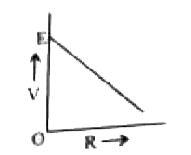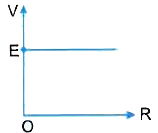A cell of emf 'E' and internal resistance 'r' is connected to a variable external resistor 'R'. The graph which gives the terminal voltage of cell 'V' with respect to R is :




The correct Answer is:B
To solve the problem of determining the relationship between the terminal voltage V of a cell and the external resistance R, we can follow these steps:
Step 1: Understand the relationship between terminal voltage, EMF, and internal resistance
The terminal voltage V of a cell can be expressed as:
V=E−I⋅r
where:
- E is the electromotive force (EMF) of the cell,
- I is the current flowing through the circuit,
- r is the internal resistance of the cell.
Step 2: Express current I in terms of R
Using Ohm's law, the current I can be expressed as:
I=VR+r
Substituting this into the equation for V:
V=E−(VR+r)⋅r
Step 3: Rearranging the equation
Rearranging the equation gives:
V+VrR+r=E
Factoring out V:
V(1+rR+r)=E
This simplifies to:
V(R+r+rR+r)=E
V(R+2rR+r)=E
Step 4: Solve for terminal voltage V
Now, we can solve for V:
V=E(R+r)R+2r
Step 5: Analyze the behavior of V as R changes
- When R=0:
V=E(0+r)0+2r=E2
- When R→∞:
V→E
Step 6: Graph the relationship
1. When R=0, V=0.
2. When R increases, V increases and approaches E as R approaches infinity.
3. The graph of V versus R starts at 0 and asymptotically approaches E.
Final Result:
The graph of terminal voltage V against external resistance R is a curve that starts at 0 when R=0 and approaches E as R becomes very large.
---
The terminal voltage V of a cell can be expressed as:
V=E−I⋅r
where:
- E is the electromotive force (EMF) of the cell,
- I is the current flowing through the circuit,
- r is the internal resistance of the cell.
Using Ohm's law, the current I can be expressed as:
I=VR+r
Substituting this into the equation for V:
V=E−(VR+r)⋅r
Rearranging the equation gives:
V+VrR+r=E
Factoring out V:
V(1+rR+r)=E
This simplifies to:
V(R+r+rR+r)=E
V(R+2rR+r)=E
Now, we can solve for V:
V=E(R+r)R+2r
- When R=0:
V=E(0+r)0+2r=E2
- When R→∞:
V→E
1. When R=0, V=0.
2. When R increases, V increases and approaches E as R approaches infinity.
3. The graph of V versus R starts at 0 and asymptotically approaches E.
The graph of terminal voltage V against external resistance R is a curve that starts at 0 when R=0 and approaches E as R becomes very large.
Topper's Solved these Questions
- CURRENT ELECTRICITYBOOK - PHYSICS WALLAHCHAPTER - CURRENT ELECTRICITYEXERCISE - Level-2
30 Videos
- ALTERNATING CURRENT BOOK - PHYSICS WALLAHCHAPTER - ALTERNATING CURRENT EXERCISE - NEET PAST 5 YEARS QUESTIONS
8 Videos
- DUAL NATURE OF RADIATION AND MATTERBOOK - PHYSICS WALLAHCHAPTER - DUAL NATURE OF RADIATION AND MATTEREXERCISE - Neet past 5 years questions
16 Videos
Similar Questions
.A cell of emf E and internal resistance r is connected across a variable resistor. Plot a graph showing variation of terminal voltage V of cell versus the current.
View SolutionA cell of emf ' ε ' and internal resistance 'r' is connected across a variable resistor 'R'. Plot a graph showing the variation of terminal potential 'V' with resistance R. Predict from the graph the condition under which 'V' becomes equal to 'ε'
View Solution
Knowledge Check
A cell of emf (E) and internal resistance r is connected across a variable external resistance . R. The graph of terminal potential difference V as a function of R is
A B
B C
C D
D
A battery of emf E and internal resistance r is connected to a variable resistor R as shown in figure. Which one of the following is true ?
 APotenital difference across the terminals of the battery is maximum, when R=rBPower delivered to the resistor is maximum when R=rCCurrent in the circuit is maximum when R=rDCurrent in the circuit is maximum when R>>r
APotenital difference across the terminals of the battery is maximum, when R=rBPower delivered to the resistor is maximum when R=rCCurrent in the circuit is maximum when R=rDCurrent in the circuit is maximum when R>>rA cell of e.mf. E and internal resistance r is connected in series with an external resistance nr. Then, the ratio of the terminal potential difference to E.M.F.is
A(1n)B1(n+1)Cn(n+1)D(n+1)n
A cell of emf 'ε' and internal resistance 'r' is connected across a variable resistor 'R'. Plot a graph showing variation of terminal voltage 'V' of the cell versus the current 'l'. Using the plot, show how the emf of the cell and its internal resistance can be determined.
View SolutionA cell of emf ε and internal resistance 'r' is connected across a variable load resistor 'R'. Draw the plots of the terminal voltage 'V' versus (i) R and (ii) the current I.
It is found that when R = 4 Ω , the current is 1 A and when R is increased to 9 Ω , the current reduces to 0.5 A. Find the values of the emf ε and internal resistance r.
View SolutionA cell of emf ε and internal resistance r is connected across a variable resistor R. Plot a graph showing variation of terminal voltage V of the cell versus the current I. Using the plot, show how the emf of the cell and its internal resistance can be determined.
View SolutionA cell of emf ‘E’ and internal resistance ‘r’ is connected across a variable load resistor R. Draw the terminal voltage V versus (i) R and (ii) the current l.
It is found that when R=4Ω, the current is 1 A and when R is increased to 9Ω, the current reduce to 0.5 A. Find the values of the emf E and internal resistance r.
View SolutionA battery of e.m.f. E and internal resistance r is connected to a variable resistor R as shown here. Which one of the following is true

View Solution
